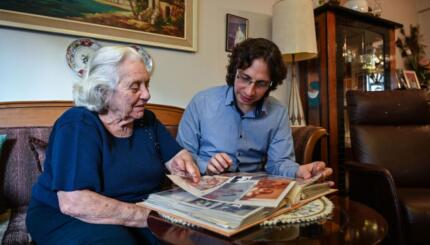From the days of silent pictures to a recent upsurge in Jewish documentaries, Jewish characters and themes have appeared at an increasing rate in American cinema. Film scholar Stuart Samuels suggests the development of Jewish themes in American cinema mirrors the status of Jews in American society. Prior to World War I, when Jewish alienation within American society was paramount, Jews appeared infrequently in popular films. The 1920s and 1930s represented an era of greater acculturation, and by the 1940s the assimilation of Jews into society and their greater visibility in American life translated to an increased screen presence. 
Beginning in the early 1900s, directors based their plots on Biblical stories to produce epic silent pieces like Samson and Delilah and The Ten Commandments. Great literary works also served as the basis for films with key Jewish characters, such as Shakespeare’s The Merchant of Venice, and Dickens’ Oliver Twist. Jewish characters, often featured as unsavory businessmen, appeared in films that tackled issues such as generational conflict, intermarriage, and struggles against discrimination.
Jews in Poland and the United States started producing Yiddish films in the 1920s, portraying not just the life of the shtetl (small Eastern European village), but the diversity and richness of the Yiddish-speaking world as a whole. Though wildly popular, the Holocaust and the decline of Yiddish in America caused the demise of the genre in the 1940s.
The 1920s also ushered in an era of acculturation regarding Jews and film. As Jews began assimilating into American society, Jewish characters and themes began to emerge on the big screen. Simultaneously, Jews began filling major studio executive roles. Al Jolson’s The Jazz Singer, a key film of the decade, follows the rise of a Jewish boy to success in America’s melting pot. Films about Irish-Jewish relations also appeared frequently, including Clancy’s Kosher Wedding (1927), and Fool’s Highway (1924).
With your help, My Jewish Learning can provide endless opportunities for learning, connection and discovery.
Stuart Samuels calls the 1920s a period of “de-Semiticization” in which Jewish characters were either downplayed or altered when books were transformed to film. In His Girl Friday–originally titled Front Page–the character of Irving Pincus became Jim Pittibone. Similarly, in the film version of Success Story, the original Jewish characters of Ginsburg and Glassman became the Irish characters of Martin and Griswold.
Films of the 1930s–such as Charlie Chaplin’s The Great Dictator (1940), Night Train (1940), and Professor Mamlock (1938)–addressed the Nazi threat to Jews, and they were followed by wartime films which marked even greater acceptance of Jewish themes in film as in society generally.
Many film historians point to the 1940s as the defining moment in which Jews entered mainstream American cinema, through popular films like Gentleman’s Agreement (1947) and Crossfire (1947). Interestingly, both of these films focused on questions of anti-Semitism rather than on questions about or from Jews themselves. Both films include Jewish characters , but the protagonists–the journalist in Gentleman’s Agreement, and the detective in Crossfire–are non-Jews who are in search of answers about anti-Semitism.
 While 1950s McCarthyism saw a clamping down on controversial themes, including anti-Semitism, the birth of the ethnic identity movement in the 1960s led to pride in Jewishness, and Jewish themes began to figure strongly in mainstream American cinema. This included films about the Holocaust and the formation of Israel, such as Judgment at Nuremberg (1961) and Exodus (1960).
While 1950s McCarthyism saw a clamping down on controversial themes, including anti-Semitism, the birth of the ethnic identity movement in the 1960s led to pride in Jewishness, and Jewish themes began to figure strongly in mainstream American cinema. This included films about the Holocaust and the formation of Israel, such as Judgment at Nuremberg (1961) and Exodus (1960).
The work of Jewish authors like Saul Bellow, Bernard Malamud, and Philip Roth provided rich material for Jewish films in the 1970s, such as Portnoy’s Complaint. Simultaneously, Jews began to appear in filmic genres from which they had been previously absent, like gangster films (Bugsy, Meyer Lansky) and Westerns (Blazing Saddles, in which Mel Brooks plays a Yiddish-speaking Indian).
There was also a dramatic increase in popular films focusing on Jews, including The Apprenticeship of Duddy Kravitz and The Heartbreak Kid. Key films such as Fiddler on the Roof (1971), Cabaret (1972), The Big Fix (1978), Hester Street (1975), and Woody Allen‘s Annie Hall (1977) also signified a definitive growth in Jewish presence in mainstream American films.
The year 1985 brought the ground-breaking nine-hour documentary Shoah, which set in motion a wave of Holocaust-themed films, both narrative and documentary. The best known, Spielberg’s Schindler’s List met with great box office and critical success, though it generated some scholarly controversy regarding its historicity and its very attempt to present the Holocaust in dramatic form. .
The advent of Jewish film festivals has vastly reconfigured distribution outlets for Jewish-themed films. Beginning in the early 1980s in San Francisco, the trend spread to New York, Toronto, and eventually to towns with much smaller Jewish populations, like Portland, Maine. Jewish film festivals continue to offer venues for strongly Jewish-themed work that often cannot find screening opportunities in more mainstream outlets.


